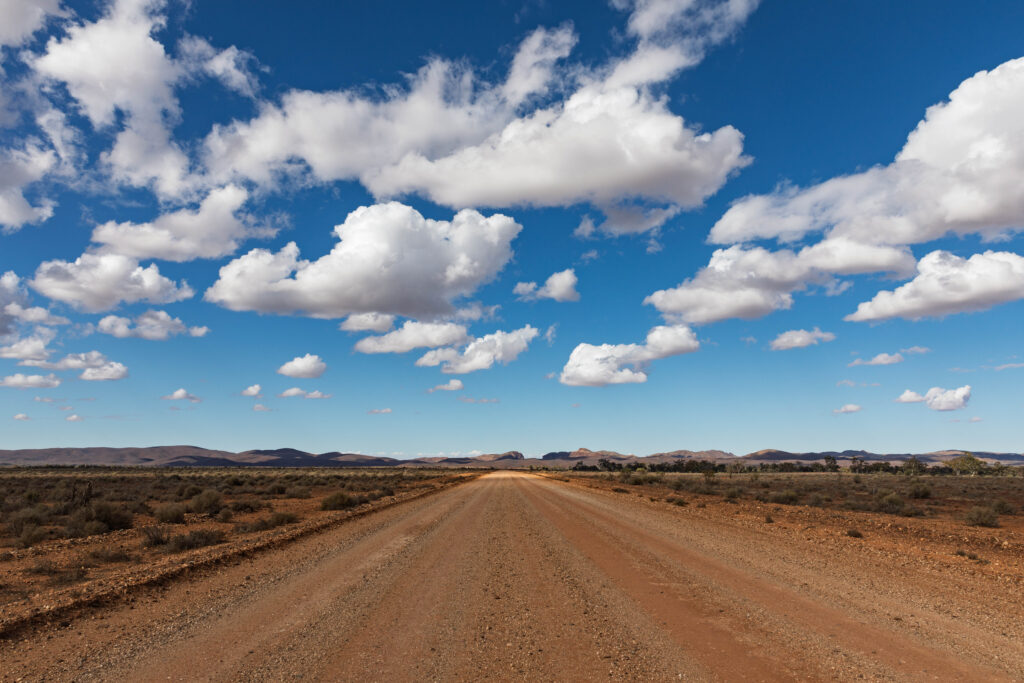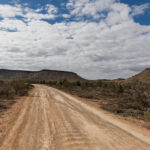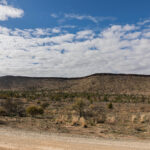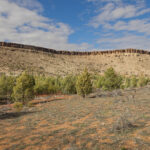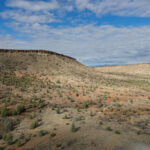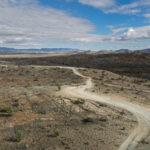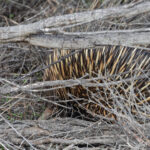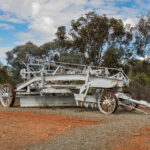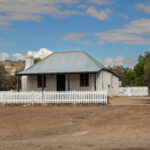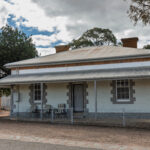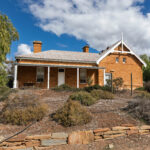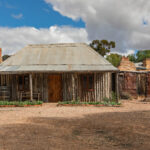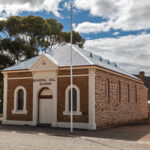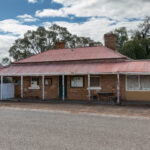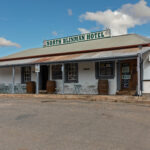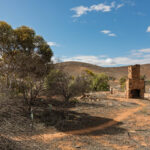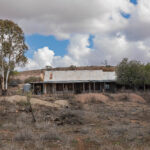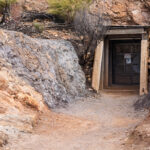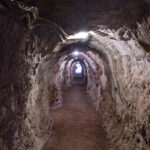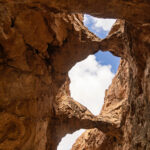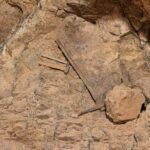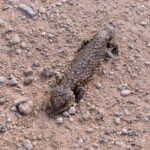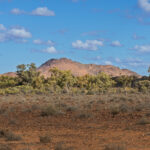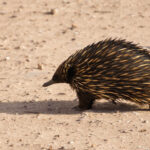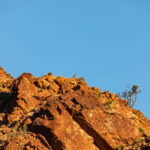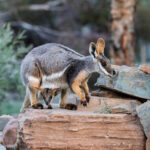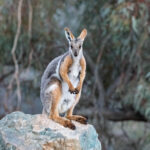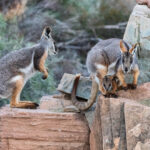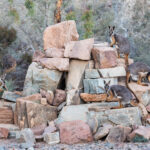Monday, 11 August 2025
We were on the move again today heading north to Arkaroola in the northern Flinders Ranges. As we drove up to Blinman we stopped at the geological feature known as the Great Wall of China. There is a ridge that has blocky stone atop it and it certainly does look like a fortress wall on top of the hill, albeit made by nature rather than built by China’s emperors. After some quick photos, including with the drone we were driving back out to the main road when I cried echidna, echidna, echidna! We have seen lots of signs of echidnas on our hikes but, until today, no actual echidnas. We still find it exciting to see echidnas in the wild only having seen a few in our lifetimes.
Arriving in Blinman about 10.15am we drove out to the mine only to discover that we should have booked at the Mine Office in the town. We drove back into town hoping to book in for the 11.00am tour only to discover that it was listed on the board as FULL. Damn! Oh well, there were spaces on the 12.00pm tour so we booked into that tour. That meant filling in an hour and a half in Blinman which is very, very small and really the ONLY thing to do is the mine tour.
So, we walked around town taking a few photographs of old buildings and then sat in the sun for a while. I spotted up on the mine booklet that we had been given and Bernie checked emails, Facebook and Apple News+ because, after two days without phone coverage, we had a strong 4G signal.
About 10.30am we headed back out to the mine where we photographed the ugly old slag heap and the quaint Mine Captain’s Cottage. By the appointed time, there were five of us at the mine entrance waiting for our guide. Our guide, Imelda, arrived right on the dot to kick of the 12.00 noon tour. Although Imelda has only been in the role for eight weeks her knowledge of mining generally and the history of Blinman mine in particular was impressive! We were taken into the mine, to a couple of different levels where we could see just a little bit of the extensive mine workings.
The Blinman Mine was the largest producer and longest operating mine in the Flinders Ranges. The mine saw four main periods of operation between 1862 and 1907 during which 10,000 tonnes of copper were extracted from 200,000 tonnes of ore. During our hour long tour we leant much, much more about the mine, far too much to remember and record!
From the mine we drove back into town for a quick lunch at The Miner’s Crib. After eating it was time to start heading north in earnest. Leaving Blinman behind us we turned left onto the North Flinders Road to travel the 152 kilometres to Arkaroola.
We had barely left town when we spotted an emu racing towards the road up ahead on our right giving every appearance that it was being chased by the hounds of hell. What is the stupid thing going to do? Should we slow down or stop and wait to see what it does? Abruptly it stopped, looked confused for a moment and then turned around to race back the way it had come. You never, ever know that an emu is going to do.
We drove through the Eregunda Valley crossing over the creek multiple times. The road had frequent floodways so it was easy to see why this route to Arkaroola was closed a week or so ago after the rain. Although it’s an unmade road the surface was pretty good for our journey today. Bernie thinks it has probably been graded since the rain to repair water damage.
Today we saw more feral goats that we have seen elsewhere on our travels during this holiday. Travelling between the southern and northern Flinders Ranges we found ourselves between national park areas so perhaps the efforts to cull the goats are less intensive outside of the parks??
On a section of road heading east towards Mount Chambers Gorge, Bernie stopped for a photograph. Since we were stopped, we both walked around the car like crazy people to stretch our legs and attain a Stand hour on our smart watches, ha, ha. Lucky there wasn’t much traffic about. In fact, we only encountered six vehicles travelling southbound during our 152 kilometres.
We only saw the Mount Chambers Gorge from a distance but our route took us through the Wearing Gorge. There were warning signs about the narrow, winding road through the gorge but we really didn’t think it seemed dangerous at all. Out the other side of the gorge Bernie spotted a shingleback (stumpy-tailed) lizard on the road. He stopped the car to photograph it and then we encouraged it to crawl off the road and back into the scrub. We can only hope that it didn’t walk straight back out onto the road.
Hmmn, Syri told us that most of our journey today was on the Flinders North Road. However, our atlas said that we had set out on the Blinman-Balcanoona Road before taking a left onto the Balcanoona-Yunta Road?? Syri said turn right onto the Gammon Ranges Road, in the atlas it was called Copley Road. Anyhow, both were in agreement about us taking a left onto Arkaroola Road.
How exciting! Not long after turning onto Arkaroola Road, Bernie spotted our second echidna for the day. Wow! This one was on the road, so we stopped to photograph it walking purposefully across the road and then made sure that it crossed all the way to the other side and was continuing to head off safely into the bush before we left.
Although there were warning signs telling us to watch for wallabies and kangaroos what we saw most of was emus. Fortunately, there were no close encounters with wildlife on this final leg of our journey and we arrived at Arkaroola just before 4.00pm. At this time of year, well and truly time to be getting off the road to avoid wildlife coming out to graze at dusk.
We were barely unloaded and in our room before it was time to see the yellow-footed rock-wallabies coming down from the nearby rocky outcrop to feed. When we were told this at check-in I thought the wallabies were going to be coming down to graze beside the creek. No! They feed the wallabies, so of course they start to come down reliably at 5.00pm because food is put out for them.
Hmmn, I was a bit concerned about the fact that they are feeding the wallabies to attract them for the tourists BUT when we were told how badly the colony has suffered during the drought it seemed more reasonable that they would supplement their feed to help them survive. We were told that it is estimated around 7,000 of the 10,000 strong colony has perished during the drought. An endangered species really cannot afford to lose so many individuals. Anyhow, misgivings about the human intervention aside, it was lovely seeing these very pretty little rock hoppers up close.
We were booked in for dinner at 6.30pm which seemed like it would give us plenty of time to eat before our scheduled ‘Explore the Cosmos’ session at 8.00pm. With our dinner for our first two nights included in our accommodation package we were encouraged to order an entree to share, a main course each and a dessert to share to maximize our value for money. Great idea BUT we were still sweating on our dessert arriving at ten to eight!! Unfortunately we ended up having to pig down our brownie without really being able to appreciate its very attractive presentation with ice-cream and seasonal fruits because … we had to go star-gazing.
From the dining table we raced across to the room where Caleb took us on a star gazing journey on his state-of-the-art array of screens attached to the telescope outside. All very interesting and, if I hadn’t eaten so much food, I would have found it much easier to stay awake in a darkened room watching a huge television screen showing: Mars, red dwarfs, white dwarfs, nebulas and other cosmic wonders!! The presentation concluded outside with a look at the telescope in its housing and Cayleb using his laser pointer to highlight: The Pointers, the Southern Cross and Scorpio. Everyone loves Scorpio. Wian was excited to show us Scorpio while we were in Africa too. With quite a bit of cloud cover this evening it was not an ideal night for star gazing but Cayleb still managed to pick out a few highlights for us.
Steps: 8,592 (5.77kms)


